AMD Ryzen 7 8700G and Ryzen 5 8600G Review: Zen 4 APUs with RDNA3 Graphics
by Gavin Bonshor on January 29, 2024 9:00 AM EST- Posted in
- CPUs
- AMD
- APUs
- Phoenix
- 4nm
- Zen 4
- RDNA3
- AM5
- Ryzen 8000G
- Ryzen 7 8700G
- Ryzen 5 8600G
CPU Benchmark Performance: Rendering
Rendering tests, compared to others, are often a little more simple to digest and automate. All the tests put out some sort of score or time, usually in an obtainable way that makes it fairly easy to extract. These tests are some of the most strenuous in our list, due to the highly threaded nature of rendering and ray-tracing, and can draw a lot of power.
If a system is not properly configured to deal with the thermal requirements of the processor, the rendering benchmarks are where it would show most easily as the frequency drops over a sustained period of time. Most benchmarks, in this case, are re-run several times, and the key to this is having an appropriate idle/wait time between benchmarks to allow for temperatures to normalize from the last test.
Some of the notable rendering-focused benchmarks we've included for 2024 include the latest CineBench 2024 benchmark and an update to Blender 3.6 and V-Ray 5.0.2.
We are using DDR5-5200 memory as per the JEDEC specifications on the Ryzen 7 8700G and Ryzen 5 8600G, as well as DDR4-3200 on the Ryzen 7 5700G and Ryzen 5 5600G. The same methodology is also used for the AMD Ryzen 7000 series and Intel's 14th, 13th, and 12th Gen processors. Below are the settings we have used for each platform:
- DDR5-5200 CL44 - Ryzen 8000G
- DDR4-3200 CL22 - Ryzen 5000G
- DDR5-5600B CL46 - Intel 14th & 13th Gen
- DDR5-5200 CL44 - Ryzen 7000
- DDR5-4800 (B) CL40 - Intel 12th Gen
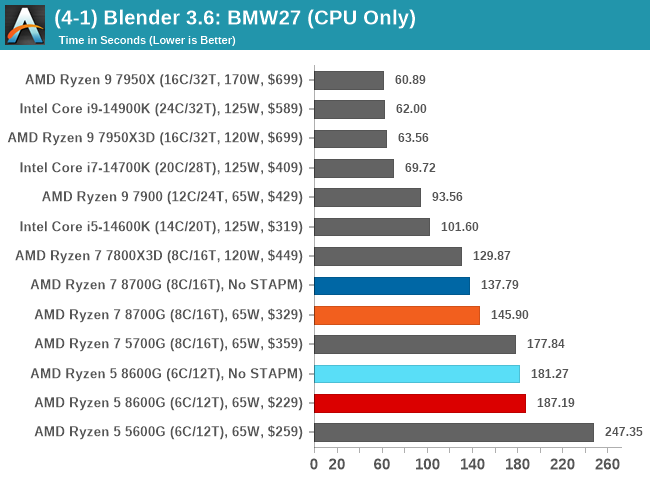
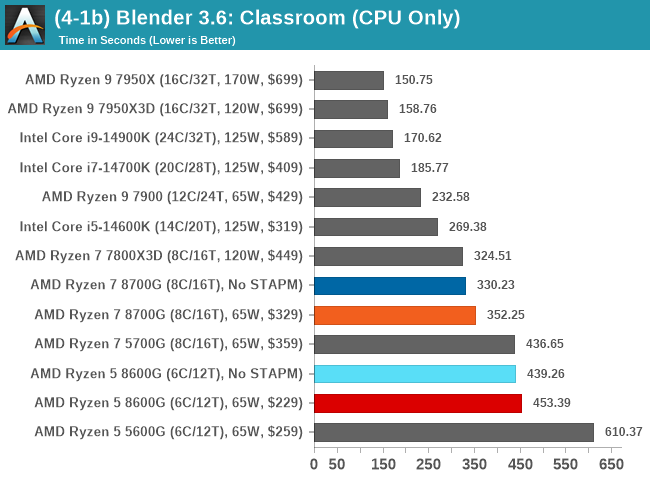
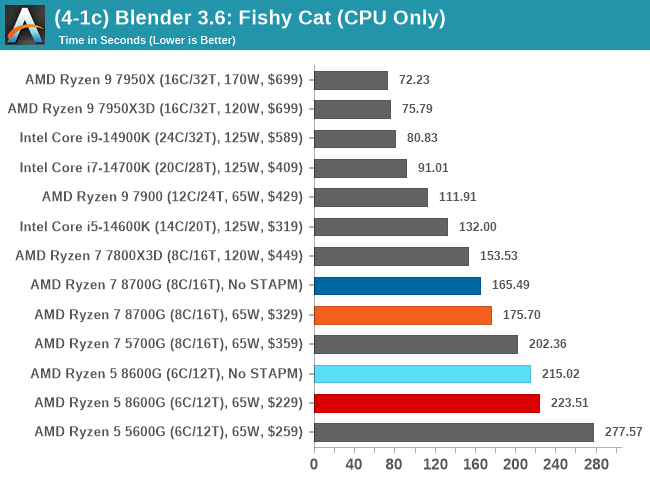
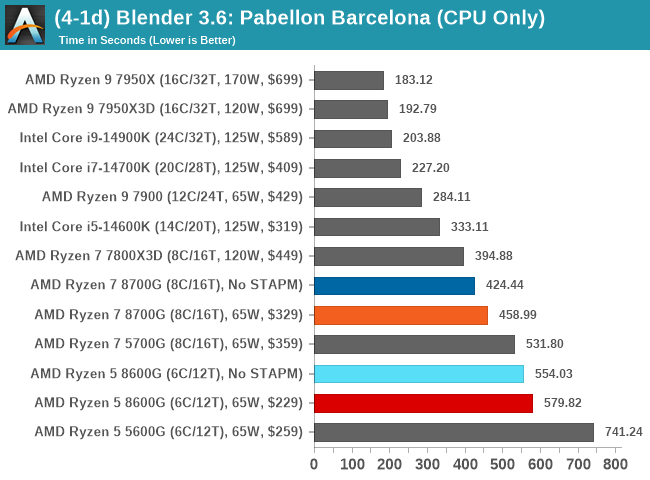

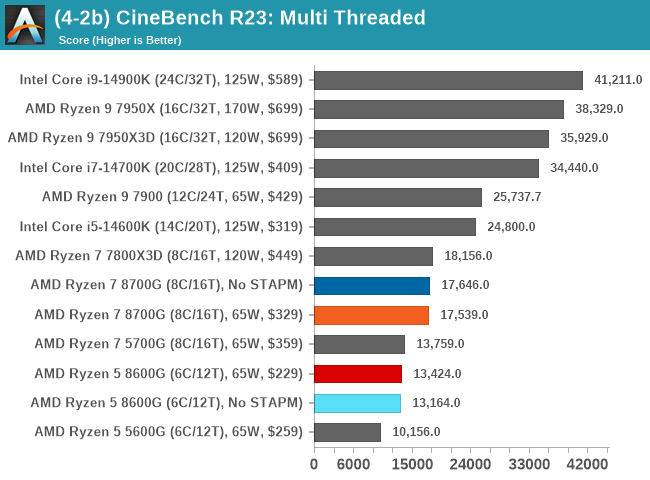
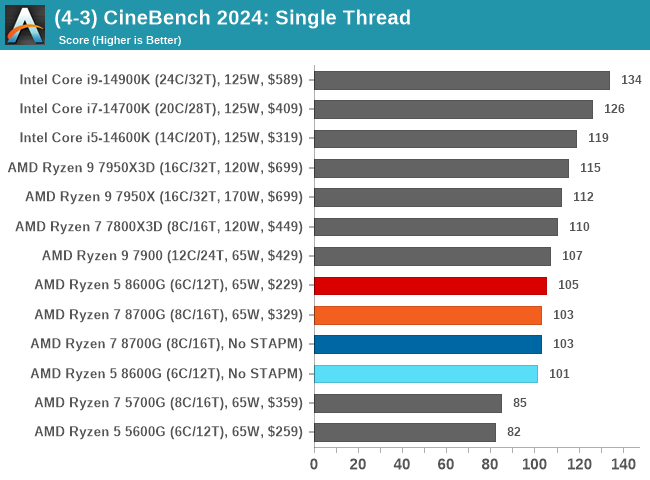
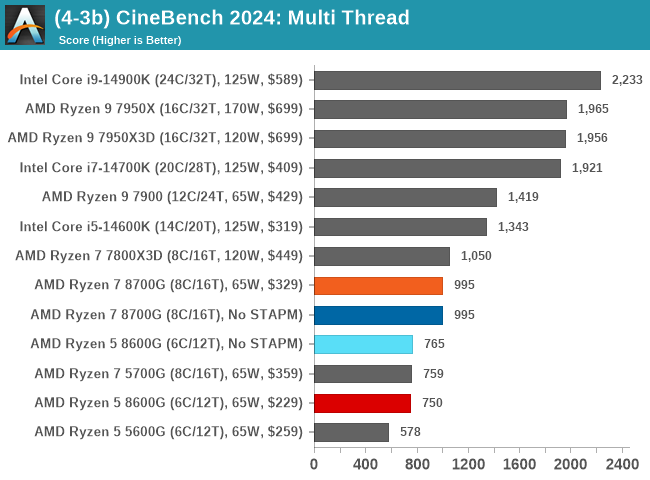

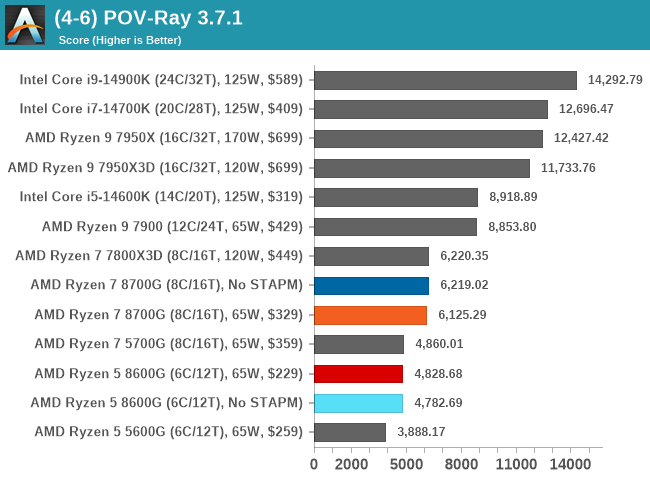
Another area where a mobile-based chip ported to a desktop doesn't quite match the bigger desktop chips is in rendering, a quintessential power and multi-threaded scenario where more cores and threads typically equate to higher performance. Both the Ryzen 7 8700G and Ryzen 5 8600G beat out the Ryzen 5000G series APUs, although the Ryzen 7 5700G consistently beats the Ryzen 5 8600G as we would expect from having two more cores with four more threads.
In our rendering tests without STAPM limitations, we saw notable gains in performance in Blender 3.6. The performance increase without sustained power loads being limited, we're seeing up to 7.5% better performance across the longer tests, with around 5% more performance in the shorter tests.










111 Comments
View All Comments
TheinsanegamerN - Wednesday, January 31, 2024 - link
For basic use a 4 core is fine. Plenty of games still run fine on 4 cores, and if you are using the iGPU your CPU cores are not going to be your limiting factor.FatFlatulentGit - Wednesday, January 31, 2024 - link
That setup would also eat over 2x as much power. The 8000G line is for people who want something with some expansion options and decent performance, but also want to keep it lower power/heat/noise, among other things. I'm eyeballing one for an HTPC upgrade.t.s - Tuesday, January 30, 2024 - link
The problem with 8700G is the price. Too pricey. I'll take socketed CPU anytime over soldered If the price is right ($200-$250). Cause when you go 7840HS route, you can get complete packages with just $490 (16GB 5600MHz, 512GB SSD, BT5.2 + WiFi6) or about $390 no RAM no SSD.GeoffreyA - Tuesday, January 30, 2024 - link
Quite a nice boost in performance over the 5000G APUs, with only a slight increase of power. Though I suppose for those already on AM4 APUs, it may be better to wait for the Zen 5 ones, and get an even bigger boost in one shot.cp0x - Tuesday, January 30, 2024 - link
I've been reading Anandtech for decades, since it started. In all that time, this is the worst review I've ever seen. We already know these chip are budget / entry level (of the latest generation). There's only one thing that is truly interesting about these chips: The integrated graphics. And specifically, the IGP at 1080p. And while we get 4 pages full of tests of a discrete GPU with this CPU, we get a total of one page with the IGP at 1080p, and it contains only one chart comparing this chip with other options (e.g. Intel), and that one chart is of ... drum roll ... Civ6 🤦♂️ WTF!?!?!?!We do get a few more graphs of 720p gaming. Why?!? WHEN THE REVIEW ALREADY EXPLAINED THAT THE STEAM STATS SHOW MOST GAMERS PLAY AT 1080P?!?!?!?
I'm not going to assume that this is a conspiracy theory. After all: "Never attribute to malice that which is adequately explained by stupidity."
Come on. Do better. This article should have been centered around and anchored on the 1080p results with this chip's IGP. It should have compared with more than just AMD's previous gen of this chip; it should have compared with Intel's offerings in this space. The questions the reader has are: What $$$ video card does this thing save me from buying? Will this play my game? How does it compare with other CPUs and their IGPs?
End rant. Do better.
cp0x - Tuesday, January 30, 2024 - link
And of course (as other commenters have pointed out): What effect does slower or faster DDR5 make on the 1080p results? (Especially since faster DDR5 was actually being used in the Intel system.)FWhitTrampoline - Tuesday, January 30, 2024 - link
The tech press in general ignores iGPUs and small form factor systems save ETA Prime and his YouTube channel. But ETA Prime is Gaming Benchmark Focused there mostly so any Blender 3D Cycles iGPU accelerated testing is ignored there. AMD tends to only focus on Games development for its APUs mostly as the console makers using AMD's APUs are more responsible for the games performance on AMD's APUs than AMD is responsible.And really the Gaming Hardware review sights are higher end Desktop Processor/dGPU focused there where Very Small Form Factor(InWin Chopin and ASRock X300/Other Desk Mini SKUs that use AMD and Intel Socket Packaged processors with powerful iGPUs make sense) system builds are ignored!
Both the ASRock X300/Desk Mini and the Inwin Chopin very small form factor system builds and are too tiny to accommodate any dGPUs and so Ryzen 5000G was popular there for the iGPU and in those builds with AMD/Intel APUs/SOCs with more powerful iGPUs. There will be an ASRock x600/AM5 Desk Mini and what is essentially the same case form factor as the X300/AM4 Desk Mini. The Inwin Chopin barely accommodates a Mini-ITX MB but lacks the room of any dGPU to get slotted into the x16 slot on a Mini-ITX MB, sans some case modding of the Chopin!
Bruzzone - Tuesday, January 30, 2024 - link
1080 gaming, well, the real application for gamers running greater than a 6000 MHz memory bus is high frequency trading. mbnandnandnand - Tuesday, January 30, 2024 - link
I think the worst crime in the review was using DDR5-5200.Thunder 57 - Wednesday, January 31, 2024 - link
AT isn't the same since Dr. Ian Cutress left.